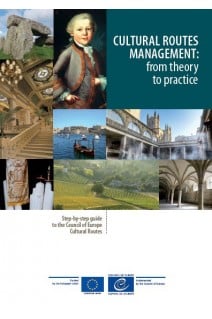

European Cultural Routes (1998)
- Exclusivité web !


In 1987, the Santiago de Compostela Declaration laid the foundations for the first Council of Europe Cultural Route, highlighting the importance of our rich, colourful and diverse European identities. Today, the Council of Europe Enlarged Partial Agreement (EPA) on Cultural Routes oversees 29 routes connecting culture and heritage across Europe.
Cultural Routes are powerful tools for promoting and preserving these shared and diverse cultural identities. They are a model for grass-roots cultural co-operation, providing important lessons about identity and citizenship through a participative experience of culture. From the European Route of Megalithic Culture with its monuments built as long as 6 000 years ago, to the ATRIUM route of Architecture of Totalitarian Regimes, the routes contain elements of our past which help us to understand the present and to approach the future with confidence.
The Cultural Routes also stimulate thematic cultural tourism in lesserknown parts of the continent, helping to develop economic and social stability in Europe.
This first ever step-by-step guide to the design and management of Council of Europe Cultural Routes will be an essential reference for route managers, project developers, students and researchers in cultural tourism and related subjects. It addresses aspects ranging from the Council of Europe’s conventions to co-creation, fund-raising and governance, and it explores a Cultural Route model that has evolved into an exemplary system for sustainable, transnational co-operation and that has proved to be a successful road map for socio-economic development, cultural heritage promotion and intergenerational communication.
The Council of Europe EPA on Cultural Routes is the result of our successful co-operation with the Luxembourg Ministry of Culture and the European Union. Increasingly, other organisations, such as the United Nations World Tourism Organization, are joining this project.
This handbook was funded by the third European Commission/Council of Europe Joint Programme on Cultural Routes.
Contents
FOREWORD
PART I – CONTEXT
1.1. The evolution of the Council of Europe Cultural Routes programme
Penelope Denu
1.2. Aims and philosophy of the Council of Europe Cultural Routes
Penelope Denu
1.3. Defining the Cultural Routes of the Council of Europe
Eleonora Berti
1.4. The cultural context: fundamental resolutions and conventions at the European and international level
Eleonora Berti
PART II – CULTURAL ROUTES – FROM IDEA TO PROJECT
2.1. How to create a Cultural Route: project phases and criteria
Eleonora Berti
2.2. The heritage of Cultural Routes: between landscapes, traditions and identity
Eleonora Berti, Alessia Mariotti
2.3. The scientific dimension of Cultural Routes: scientific boards and networks of knowledge
Maria Gravari‑Barbas
2.4. Tourism and Cultural Routes: clusters, cultural districts and tourism systems
Alessia Mariotti
2.5. Tourism, community and socio‑cultural sustainability in Cultural Routes
Yoel Mansfeld
2.6. Communicating a path: marketing and branding of Cultural Routes
Nick Hall
2.7. Project application, assessment, evaluation and certification
Eleonora Berti
2.8. Cultural Routes evaluation
Kseniya Khovanova‑Rubicondo
PART III – TOOLS FOR THE GOVERNANCE OF CULTURAL ROUTES
3.1. Council of Europe Cultural Routes networks governance and sustainable development
Kseniya Khovanova‑Rubicondo
3.2. New tourists and new tourism strategies for Cultural Routes
Wided Madjoub
3.3. Fundraising for the Cultural Routes of the Council of Europe
Marianna Martinoni
3.4. Guidelines for Cultural Routes management plans
Eleonora Berti, Alessia Mariotti
GLOSSARY
AUTHORS
APPENDICES
Télécharger un extrait (1000)



In 1987, the Santiago de Compostela Declaration laid the foundations for the first Council of Europe Cultural Route, highlighting the importance of our rich, colourful and diverse European identities. Today, the Council of Europe Enlarged Partial Agreement (EPA) on Cultural Routes oversees 29 routes connecting culture and heritage across Europe.
Cultural Routes are powerful tools for promoting and preserving these shared and diverse cultural identities. They are a model for grass-roots cultural co-operation, providing important lessons about identity and citizenship through a participative experience of culture. From the European Route of Megalithic Culture with its monuments built as long as 6 000 years ago, to the ATRIUM route of Architecture of Totalitarian Regimes, the routes contain elements of our past which help us to understand the present and to approach the future with confidence.
The Cultural Routes also stimulate thematic cultural tourism in lesserknown parts of the continent, helping to develop economic and social stability in Europe.
This first ever step-by-step guide to the design and management of Council of Europe Cultural Routes will be an essential reference for route managers, project developers, students and researchers in cultural tourism and related subjects. It addresses aspects ranging from the Council of Europe’s conventions to co-creation, fund-raising and governance, and it explores a Cultural Route model that has evolved into an exemplary system for sustainable, transnational co-operation and that has proved to be a successful road map for socio-economic development, cultural heritage promotion and intergenerational communication.
The Council of Europe EPA on Cultural Routes is the result of our successful co-operation with the Luxembourg Ministry of Culture and the European Union. Increasingly, other organisations, such as the United Nations World Tourism Organization, are joining this project.
This handbook was funded by the third European Commission/Council of Europe Joint Programme on Cultural Routes.
Attention, en vertu de nos conditions générales de vente, l'achat des PDF/epub est réservé aux particuliers.
